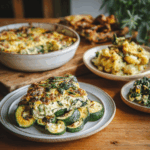Follow Me On Social Media!
Ricotta Cottage Cheese: The Delicious Duo Transforming Classic Comfort Food
If you’ve ever stood in the dairy aisle debating between ricotta and cottage cheese, you’re not alone. These two creamy staples have distinct flavors and textures but surprisingly similar roots—and they’re showing up together in exciting new recipes across American kitchens. This post dives into the delightful pairing of ricotta and cottage cheese: how they compare, where they shine, and how you can use them both to create lighter, protein-rich comfort foods.
The Story & Intro: How Ricotta Cottage Cheese Became My Secret Weapon in the Kitchen
Growing up in Savannah, Georgia, my grandmother always had a tub of ricotta in the fridge, ready for lasagna night. Years later, in my own kitchen, I found myself reaching for something similar but a bit lighter: cottage cheese. That was the beginning of a delicious discovery. Combining these two creamy wonders—ricotta for its richness and cottage cheese for its protein punch—has become my go-to trick for upgrading old-school dishes with a balanced twist.
My favorite part? The versatility. I’ve stirred them into pasta bakes, spooned them over roasted vegetables, even swirled them into desserts. One of my most popular dishes right now is this hybrid version of ricotta mac and cheese, which blends the silkiness of ricotta with the gentle tang of cottage cheese. It’s a creamy, dreamy upgrade to a nostalgic classic.
When friends ask if they can swap ricotta for cottage cheese or vice versa, the answer is: absolutely—if you know how to play to their strengths. In this post, we’ll break down their differences, show you when to use each, and even inspire you with some simply seasoned recipes, like my spinach ricotta cheese quiche and protein-packed pairings you’ll want to try today.
Let’s dive in and make your next dish both delicious and nourishing with ricotta cottage cheese.

Comparing Ricotta and Cottage Cheese: Texture, Taste, and Nutrition
Understanding the texture and taste differences
When you scoop a spoonful of ricotta, it’s smooth, fluffy, and slightly grainy—a creamy dream in baked pasta or spread over toast. Cottage cheese, on the other hand, has small curds suspended in a milky liquid, giving it a chunkier, wetter consistency. That’s why it shines in savory bowls and protein-heavy breakfasts.
Ricotta delivers a mild, slightly sweet flavor. It’s a natural fit for dishes like ricotta cheese filling for lasagna or a dessert with ricotta cheese, where its gentle profile pairs well with herbs or sugar. Cottage cheese, by contrast, has a slightly tangy bite and a saltier finish, making it great for balancing richer ingredients like eggs or meats.
Nutrition breakdown: Which is healthier?
The short answer: it depends on your goal. Ricotta is higher in fat, especially if you use whole milk versions, but it’s rich and satisfying. Cottage cheese is typically lower in fat and higher in protein, which makes it a popular option for those watching calories or trying to boost daily protein intake.
Take my go-to breakfast: a bowl of cottage cheese blended with a touch of ricotta for creaminess. It’s protein-packed, satisfying, and a fantastic way to start the day. You’ll also love how well they combine in recipes like chicken with ricotta cheese, where the cottage cheese adds body without overpowering flavor, and ricotta brings that soft, luscious texture.
In fact, if you’re curious about the protein potential, my ricotta cheese protein breakdown covers how this combo can be a powerhouse ingredient for balanced meals.

Smart Substitutions: When to Use Ricotta, Cottage Cheese—or Both
Ricotta cottage cheese swaps that actually work
In so many dishes, the key to making meals lighter without losing richness is this powerful pair: ricotta cottage cheese. Whether you’re cooking breakfast, lunch, or dinner, knowing when to substitute ricotta for cottage cheese—or combine the two—can completely change your cooking game.
Let’s say you’re making a creamy baked dish like macaroni and cheese with ricotta. Ricotta gives that velvety texture we love, but sometimes it feels a bit heavy. Here’s where cottage cheese steps in. By blending ricotta cottage cheese together, you keep the creamy richness while cutting back on fat and adding protein.
Trying a healthier version of lasagna? Use ricotta cottage cheese instead of only ricotta in your spaghetti pie with ricotta cheese or in a basic baked ziti. The cottage cheese lightens the feel, while ricotta still gives you that classic Italian vibe.
Using ricotta cottage cheese in sweet vs. savory recipes
Here’s where things get really fun. Ricotta cottage cheese works in everything from quiche to desserts. For savory dishes like frittatas or casseroles, cottage cheese adds a great salty edge. In sweets, like muffins or cheesecake, ricotta softens the sharpness and provides creaminess.
Try combining them in your next recipe—say, a lightened-up cheesecake. Blend ricotta cottage cheese until smooth, and you’ll get a silky base that rivals full-fat cream cheese. If you’re baking, it also helps keep muffins moist without weighing them down.
In fact, I often add ricotta cottage cheese to my eggs in the morning or use it in a spread for toast with honey and lemon zest. It’s simple, wholesome, and deeply satisfying—just what my cooking philosophy is all about.
Easy Recipes Using Ricotta Cottage Cheese for Any Meal
Quick breakfast and brunch recipes with ricotta cottage cheese
If you’re looking for a way to make your mornings more nourishing, ricotta cottage cheese is your new best friend. I often stir a few spoonfuls into scrambled eggs or fold it into muffin batter for added creaminess and protein. One favorite in my kitchen is a quick frittata loaded with spinach and topped with a ricotta cottage cheese blend. It comes out fluffy and flavorful—no need for heavy cream.
For a cozy weekend brunch, try a twist on the classic quiche. My spinach ricotta cheese quiche uses both cheeses to keep things creamy but light. And if you enjoy baking, add a spoonful of ricotta cottage cheese to your pancake or muffin batter. It gives baked goods a tender crumb without the weight of butter or oil.
Hearty dinners and satisfying sides with ricotta cottage cheese
Dinner is where ricotta cottage cheese really shows off. Use it in stuffed shells, layered bakes, or pasta dishes to keep things rich but not overly heavy. My secret? I blend equal parts ricotta and cottage cheese until silky, then stir in herbs, garlic, or lemon zest depending on the dish.
Looking for something comforting? My ricotta mac and cheese gets a major boost when you blend ricotta cottage cheese into the béchamel. It melts beautifully and adds a gentle tang.
You can also stuff chicken breasts with ricotta cottage cheese, sun-dried tomatoes, and spinach for a protein-rich dinner that’s fancy enough for guests. For a sweeter spin, don’t skip dessert. Blend ricotta cottage cheese with honey, vanilla, and berries for a no-bake treat that tastes indulgent but feels light.
Whatever your flavor preference, ricotta cottage cheese offers endless flexibility. It brings balance to every bite and earns its place in both sweet and savory meals across the week.
Frequently Asked Questions about Ricotta Cottage Cheese
Are ricotta and cottage cheese the same?
No, ricotta and cottage cheese are not the same, though they look similar. Ricotta is made from the whey left over after making other cheeses and has a finer, creamier texture. Cottage cheese is made from curds and contains more moisture and a distinct curdy feel. That said, combining ricotta cottage cheese can deliver the best of both worlds—smoothness and lightness in one bowl.
Can I substitute ricotta cheese with cottage cheese?
Yes, you can substitute ricotta with cottage cheese in many recipes. For baked dishes like spaghetti pie with ricotta cheese or even in muffins, cottage cheese works beautifully when blended. However, the texture and flavor will be slightly different. Using a mix—ricotta cottage cheese—often results in a better balance, especially in lasagna or casseroles.
Is Cottage a ricotta cheese?
No, cottage cheese is not a form of ricotta cheese. They’re made differently, from different parts of milk. Ricotta is traditionally made from whey, while cottage cheese comes from curds. Still, many home cooks and chefs now blend ricotta cottage cheese together to create a healthier, high-protein alternative in cooking and baking.
What is the healthiest cheese you can eat?
Cottage cheese ranks high on the list for healthiest cheeses due to its low fat and high protein content. Ricotta is also a good choice—especially part-skim versions—for its calcium and softer profile. When you combine ricotta cottage cheese, you get a creamy, satisfying mix that supports balanced eating without sacrificing flavor.
Conclusion:
Ricotta cottage cheese isn’t just a trend—it’s a kitchen game-changer. Whether you’re lightening up a comfort dish, boosting protein in breakfast, or whipping up a creamy dessert, this duo offers balance, flavor, and flexibility. I’ve used ricotta cottage cheese in everything from desserts to savory bakes and even in mac and cheese, and every time, it delivers.
Cooking doesn’t have to be complicated. Sometimes, it’s as simple as two cheeses coming together to create something nourishing and satisfying. So go ahead—try blending ricotta cottage cheese in your next meal. It just might become your secret ingredient too.





